So let's dig this back up from the grave...
After months of life-craziness, I'm FINALLY getting things arranged in the garage workspace. I decided to sell my little shaper; it's been fun, but I'm not using it regularly and it was too nice (and too large) to hang onto...so I've been slowly working on cleaning up the Millrite...and Holy F-ing Moses, does it need cleaning. I honestly didn't realize how dirty and grease-caked it really was until I started digging into it.
Pictured: The Forbidden Nutella.
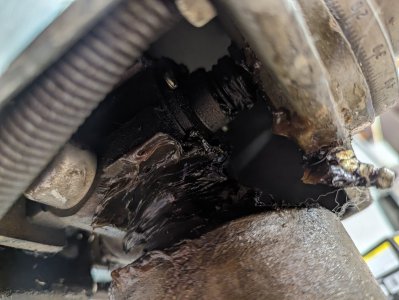
That's just a little section under the bed that I haven't reached, yet; the entire thing looked like that before I started swabbing it away.
Pictured: More horror.
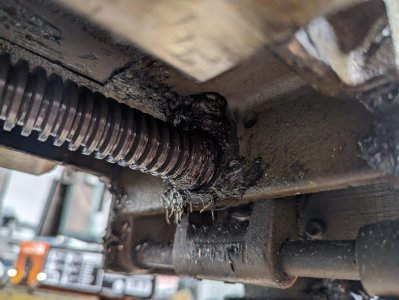
Honestly, now that I look at these two pictures I can say that this isn't the worst of it, because the caked-on foulness shown here is still mostly petroleum-based; in the more exposed areas, it was mostly chip and shaving and swarf that was being
held together by grease...so, basically a low-grade lapping compound. I'm sure that did wonders for the ways.
On that note: since
@pontiac428 puts up with me bothering them via PM, I had mentioned the need to get this thing actually secured to the floor and trammed, which led to my discovering - via some very crude means, admittedly - that the table has a bit of...well,
slope to it. When I traverse the X-axis, I've noticed that there's about a .007" difference showing up: the left side is high...and the weird thing is that it's not a linear difference. If I start with the table positioned at the extreme right and move it to the left, the first six or eight inches fall off rapidly...and then it's flat for the remaining 24" of movement. The wear on the top of the table doesn't indicate one side being worn more than the other, so the thought was that there could be a pile of grease and terribleness between the table and the saddle that's causing it to heave when in that position. Having looked underneath the table...yeah, that could definitely be the case. It's pretty cruddy under there, on both sides.
Pictured: Why is there grease here in the first place?
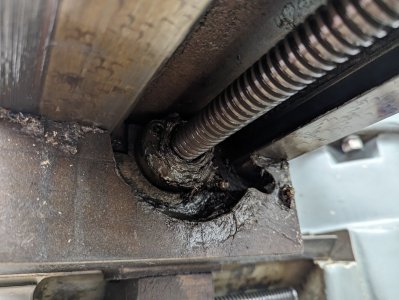
I guess the good news is that the ways can't be
too worn if those scrapings are still so visible...but again: this this is really dirty. The pictures actually make it look cleaner, somehow...but the parts that I've cleaned up actually look pretty decent.
Pictured: Less-awful.
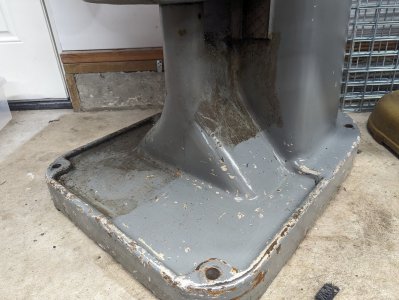
I didn't know this thing was actually a nice shade of light grey underneath all of that neglect...but I did know that the floor underneath the machine was also made of neglect, in that it was terribly out of level and uneven: I could literally rock the top of the mill back and forth by a couple of inches. So, I decided to build some spacers/isolators and anchor it...and that was eye-opening.
Pictured: Uhhhh....
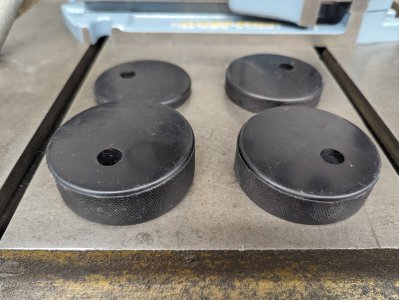
...yeah. About that.
So, the Millrite has a mounting pattern of 18" by 24", and the shortest of those hockey pucks -
< ahem > "spacers"... - is 5/16" thick; the tallest is a full inch. Thus, in somewhere around two feet of run, my garage floor slopes by 11/16"...and that explains why things randomly roll around, and by "things" I mean "entire toolboxes." Here's a clearer shot of the height differences.
Pictured: Four of these things are not like the others.
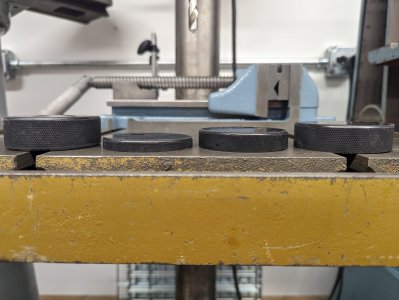
Side Note: the drill press isn't level, either, but that's a project for another day.
So, yeah, I had to cut and shorten those to make them work and get the mill halfway level; I know they're not the greatest solution, but they're inexpensive and they did the job. Same goes for the anchors: I sank a 2"-deep hole under each mounting hole in the machine base - thankfully the 5/8" SDS bit slipped right through - and used a drop-in flush anchor in the concrete; those got hammer-set, and then a 1/2-13" grade 5 was put through a thick washer and snugged down. It's surprisingly movement-resistant, now.
Pictured: Mo-betta.
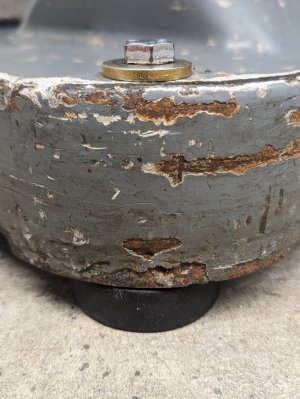
Sooooooo... I guess today's project is to keep cleaning and figure out how to get the table off the saddle. The only instruction manual I have doesn't tell me how to do that, so I'm going to do some Googling and then probably just jump in and break something from being impatient to see this thing up and running correctly.
More to come; stay tuned.








